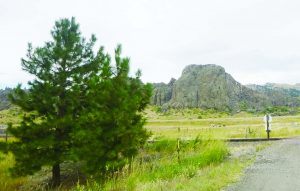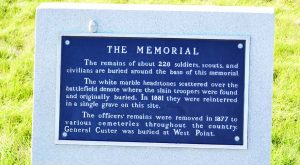By James C. Fulmer | Past President, NMLRA
“Friendship increases by visiting Friends, but by visiting seldom.”
—Benjamin Franklin, (1751 Poor Richards Almanac)
Since my retirement I have been visiting many friends around the country. Almost all of my friends share the same passion of mine for muzzle loading. All of my friends have a passion for the “path less traveled.” You all know friends like that, the ones who make anything they want or do anything they want. They are always learning new crafts and constantly learning about everything. We all tend to surround ourselves with people who we can learn from and with whom we can share what we know. These are people who you share your thoughts out loud with; they are your true friends.

Tower Rock. “From it I saw that evening immense herds of buffaloe in plains below.”—Meriwether Lewis, July 16, 1805
One of my friends, David Keene, asked Buddy Townsend and me several times to go fly fishing with him on the Missouri river out in Montana. Dave and I had met while he was serving on the Executive board of the National Rifle Association and Buddy and I where serving on the National Muzzle Loading Rifle Association Executive Board. Dave and I are both Past- Presidents of our Associations and have much in common.
Dave wrote a book a few years ago “Shall Not Be Infringed” along with Thomas Mason. It is a must read for everybody to understand why we need to elect officeholders who will protect our Second Amendment freedoms. Our rights are being regulated away daily and if there are not good judges appointed to overturn these anti-gun regulations we will lose our Civil Rights by regulations not legislation. If a Congressman or Senator or anyone voted into position by the people supports a piece of legislation that is not of our liking we have the right to vote them out. A political appointee can write regulations that will have a direct effect on our Civil Rights and doesn’t have to answer to voters. It is a good book and a must read.
When Buddy and I finally accepted the offer to go fly fishing with David, Buddy thought it would be nice if we gave David a flintlock long rifle. Buddy is a very talented gun-maker and decided he was going to build one. Buddy decided on a .50 caliber which is 7/8 of an inch across the flats and a full 42 inches long with the stock made out of walnut. The flintlock rifle weighs in at a little less than 8 and half pounds. With its set triggers it will be great not only for hunting whitetail size animals but also great for target shooting.
November is when deer seasons start around the country and if you are looking for a caliber to hunt deer and shoot competition I do recommend the .50 caliber. The .50 caliber with 80 grains of FFG and a.490 round ball which weighs about 180 grains has the velocity of roughly 1,800 feet per second with 1,300 foot pounds of energy at the muzzle. It makes the .50 caliber deadly with round ball out to 80 yards and beyond. That is probably one of the reasons it has become the nation’s favorite caliber for the muzzleloader. Round balls are deadly at close range. The Minie ball, Maxi ball and sabot style bullets only take an advantage once you start shooting at big game over 100 yards. At those yardages the foot pounds of energy generated because of the weight of the bullets for a .50 cal., which are 300 grains or more, and the bullet design helps it maintain its velocity. The energy is nearly double that of a round ball over 100 yards. But the rifle needs a rate of twist in its rifling to handle a bullet design. Most of my rifles are made for round balls. Mostly the reason I like them is because they are easier and cheaper to shoot and fun.
Many of you have made trips like this with a wild dash across country. I left my house in Pennsylvania, traveled to Buddy’s house in Indiana, then to his brother Paul’s house in South Dakota, then onto David Keene’s place in Montana. We passed many great places that are a must stop and see (yes, we got our 5 cent cup of coffee at Wall Drug in South Dakota.) But we did stop at the Little Big Horn Battlefield.
This trip was the third time I have stopped there over 40 years. It was a first for Buddy. If you’ve never been there, but read about the Indian Wars and the Little Bighorn Battlefield, until you are on site you really don’t understand. The Battle took place over a period of two days June 25th and 26th 1876 between about 1,500 and 2,000 Lakota, Cheyenne, and Arapaho Warriors and the 7th Calvary Regiment of the United States Army. There was around 600 US Cavalrymen and Scouts of which 5 of the 12 companies where totally annihilated. These men were led by Lt. Col. George Armstrong Custer who was killed with along over 210 of his men who were with him. The main fighting for them lasted just over two hours. Another 53 who were killed under the command of Maj. Marcus Reno and Capt. Fredrick Benteen who would fight the rest of the day and the next till the Indians decided their position was too well fortified to break. It is estimated the Indians lost no more than 100 killed. It seems that I get to visit there every ten years and I am amazed how much more is being learned about the battle. There has been something new and interesting there every time.
We arrived at David’s fishing camp early in the morning. We talked about the trip and telling him about visiting everything we did on the way to his camp in Montana. We immediately went fly fishing on a small river that was in front of his camp. That is what we had come out for and we caught lots of big brown and rainbow trout over the next three days. David had made arrangements for Buddy and I to do a fly fishing float trip down the Missouri with a river guide named Jay Dixon.
I never thought I would be floating the Missouri River in Montana where the Lewis and Clark Expedition had passed through when they followed the Missouri River to its head waters. From May 1804 to September 1806 the expedition would map and explore the land that President Thomas Jefferson had bought from France in the Louisiana Purchase in 1803. And find a practical passage to the west and find out what resources exactly the United States now owned.

Little Big Horn battlefield is a must-see when traveling in Montana.
On the drift trip we would fish from just north of the modern-day Craig, south of Cascade, MT. We pulled the drift boat out of the Missouri River with the view of Tower Rock directly across from where we landed. Tower Rock is a state park and Meriwether Lewis on July 16, 1805 would make an entry in his journal: “From it I saw that evening immense herds of buffaloe in the plains below.” With Tower Rock overlooking our drift boat in the Missouri River Buddy caught the only one on this whole fishing trip: a whitefish. Whitefish are native to Montana and Lewis wrote about them in his journal in 1805 when he first encountered them in the waters of western Montana. Our guide Jay was probably more excited about the whitefish we caught than all of the brown and rainbow trout we caught together. The reason was Jay knew our love of history and the whitefish was part of history. Lewis wrote in his journal June 12, 1805, “ I amused myself catching those white fish mentioned yesterday……they bit most freely at the melt (spleen) of a deer which Goodrich had brought with him for the purpose of fishing.” The whitefish was a great way to end that float on the Missouri.
One of the main purposes of this trip was to present David Keene with the .50 cal. flintlock rifle. That night after one of my best days of fishing ever, we presented David with the rifle. Nobody could have been more surprised and happy than Dave. The friends all of us have acquired through the years, whether target shooting, hunting, trapping, rendezvousing, fishing, or for me mostly through the shooting sports in general, have grown and become some of my dearest and best friendships.
Buddy and I packed up and eventually had to make the long trip home. We both made many new friends along the way on this trip and our friendships will grow with time. But that moment in time in Montana will always be remembered as a memory that goes “Beyond Friendship.”



